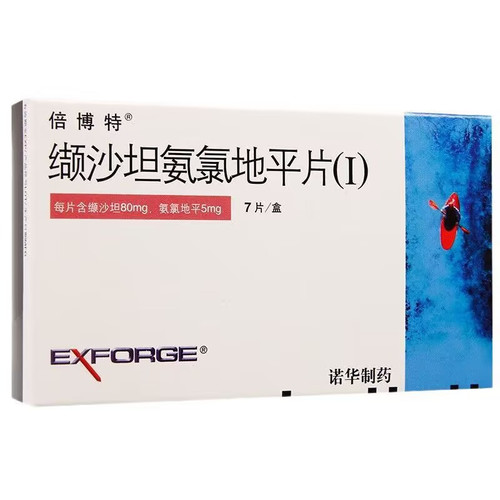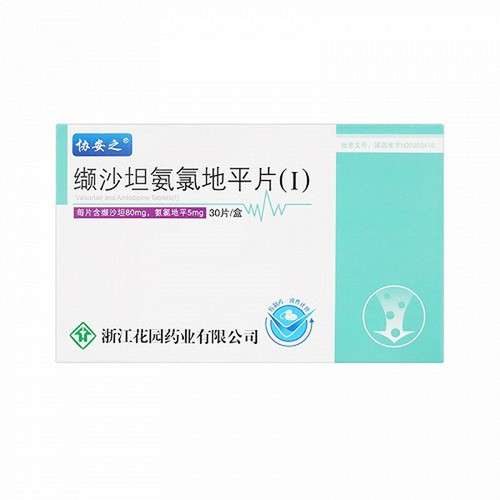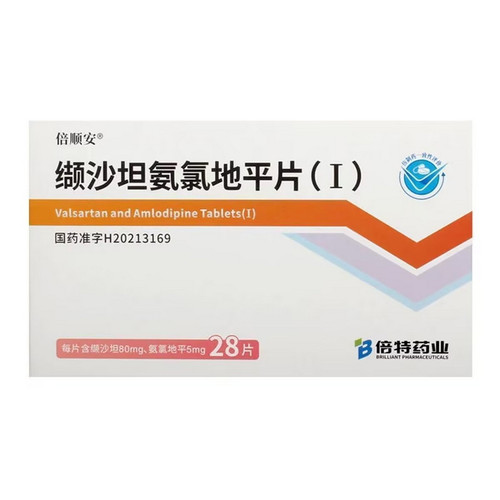Product Overview
[Drug Name]
Generic Name: Valsartan and Amlodipine Tablets (I)
Trade Name: FuDaLe Valsartan and Amlodipine Tablets (I) 80mg: 5mg*28 tablets
Pinyin Full Code: FuDaLe ZuoShaTanAnLvDiPingPian (I) 80mg: 5mg*28 tablets
[Main Ingredients]
This product is a compound preparation, containing: 80mg valsartan and 5mg amlodipine per tablet.
[Properties]
This product is a film-coated tablet that appears white after removal of the coating.
[Indications/Main Functions]
Treatment of essential hypertension. This product is used for patients whose blood pressure cannot be adequately controlled with monotherapy.
[Precautions]
See package insert for details.
[Drug Interactions]
This product is contraindicated in patients with allergies to the active ingredient or any of the excipients. It is contraindicated in pregnant and lactating women (see [Use in Pregnant and Lactating Women]). Currently, there are no data on its use in patients with severe renal impairment (creatinine clearance <10 ml/min). This product should be contraindicated in patients with hereditary angioedema and those who develop angioedema early in treatment with ACE inhibitors or angiotensin II receptor blockers. Angiotensin receptor blockers (ARBs) (including valsartan) or angiotensin-converting enzyme inhibitors (ACEIs) should not be used concomitantly with aliskiren in patients with type 2 diabetes (see [Drug Interactions]).
[Specifications]
80mg: 5mg x 28 tablets
[Dosage and Administration]
Amlodipine 2.5mg to 10mg once daily is effective for the treatment of hypertension, while the effective dose of valsartan is 80mg to 320mg. In clinical trials of once-daily valsartan-amlodipine tablets, the antihypertensive effect increased with increasing doses of amlodipine 5mg to 10mg and valsartan 80mg to 320mg. Adverse reactions to valsartan are generally dose-independent; adverse reactions to amlodipine are both dose-dependent (primarily peripheral edema) and dose-independent, with the former being more common than the latter. Patients whose blood pressure is not adequately controlled with monotherapy can be switched to this product. • Add-on therapy: Patients whose blood pressure is not adequately controlled with amlodipine or valsartan monotherapy can be switched to this product in combination therapy. Patients who experience dose-limiting adverse reactions with amlodipine or valsartan monotherapy can be switched to this product, using a lower dose of the single agent combined with the other component to achieve blood pressure control. The majority of the therapeutic effect is generally achieved within 2 weeks of initiating or changing the dose. If pregnancy is detected, discontinue this product immediately. Drugs that directly act on the renin-angiotensin system can cause harm to the developing fetus, including death. • Alternative therapy: For ease of administration, patients receiving amlodipine and valsartan combination therapy can be switched to this product at the same dose. Both amlodipine and valsartan can be taken with or without food. This product is recommended for use with water. No dosage adjustment is required for patients with mild or moderate renal impairment. Use with caution in patients with severe renal impairment (see [Contraindications]). This product should also be used with caution in patients with hepatic impairment or biliary obstructive disease (see [Precautions]).
[Adverse Reactions]
See the package insert for details.
[Contraindications]
This product is contraindicated in patients with hypersensitivity to the active ingredient or any of the excipients. It is contraindicated in pregnant and lactating women (see [Use in Pregnant and Lactating Women]). No data are available for use in patients with severe renal impairment (creatinine clearance <10 ml/min). This product should be contraindicated in patients with hereditary angioedema and in patients who develop angioedema early in treatment with ACE inhibitors or angiotensin II receptor antagonists. Angiotensin receptor blockers (ARBs) (including valsartan) or angiotensin-converting enzyme inhibitors (ACEIs) should not be used concomitantly with aliskiren in patients with type 2 diabetes (see [Drug Interactions]).









